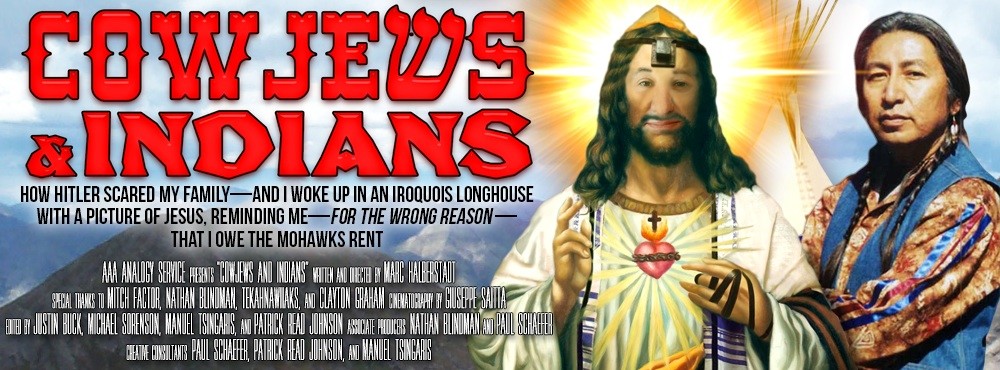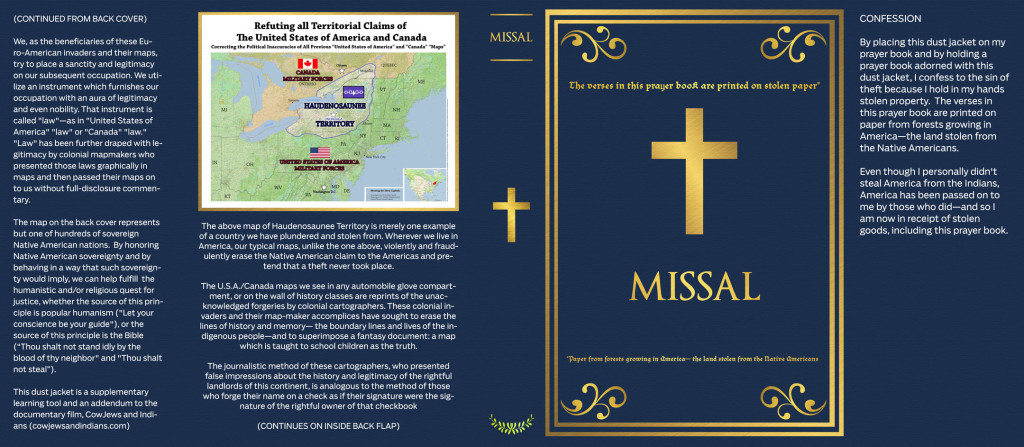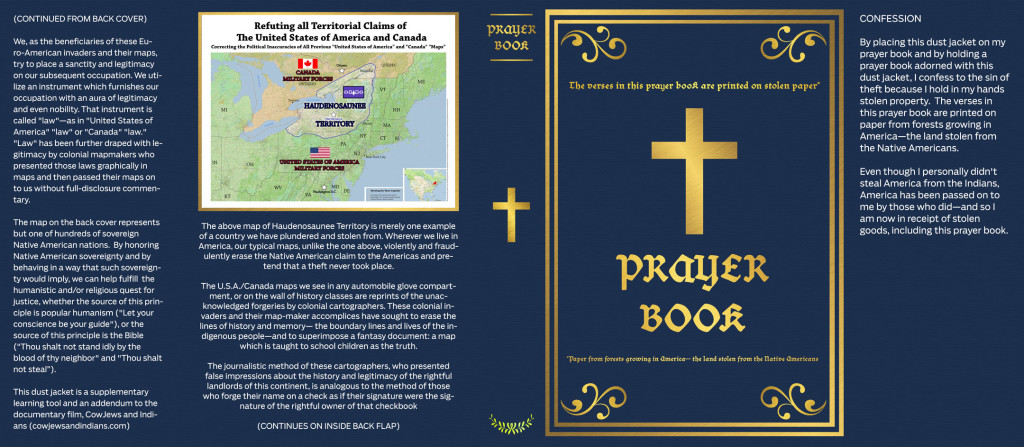Stolen Prayer Books on Yom Kippur: An Editorial
I want to provide synagogues with new dust jackets for our prayer books. The dust jackets say, “The verses in this prayer book are printed on stolen paper* (* Paper from forests growing in America––the land stolen from the Native Americans” ) (please see image)
The dust jacket continues with, “Even though I personally didn’t steal America from the Indians, America has been passed on to me by those who did––and so I am now in receipt of stolen goods, including this prayer book.”
While I have developed new dust jackets for Christian hymnals and missals as well, I’m rushing to present this dust jacket to Jews because we Jews are approaching Yom Kippur, the Jewish Day of Atonement, which arrives Friday, September 13.
Can a traditional Jew be concerned about the historical loss of his spiritual homeland, Israel, and not be concerned about living on and profiting from the spiritual homeland that the Native Americans lost?
Regarding Native Americans, how does a Jew on Yom Kippur answer the question, “Where is your brother Abel?” How does a Jew deflect the injunction, “Do not stand idly by the blood of your neighbor.”
One such neighbor is Tekahnawiiaks, a.k.a. Joyce King, a Mohawk who incorporated an analogy supplied by AAA Analogy Service (my company that produced the film) into an essay that was published by the Cornell Journal of Law and Public Policy in the summer of 2008:
“I propose that there are three levels of regard for the land: a low level, a medium level, and a high level. The low-level view of the land is based on the land being viewed as a commodity, a utility. You grow food on it, live off it, buy it, sell it and so forth. On this level, land has merely practical value. It is regarded as a commodity called real property.
The medium level is understood by most people. People who live on the land for many generations become attached to it as they are born and die on this land. They will speak of the land in familial terms such as: the Father land, or Mother Russia. On this level, the land is considered homeland. People love their homeland and would die defending it. This is a very patriotic view and most people might consider what I am calling a medium level regard for land as the highest possible view of land.
However, I would like to suggest a yet higher regard for the land. For the Haudenosaunee [aka Iroquois], not only is this land our homeland, but the Creator has assigned the land to us. For many, this may be a new idea. But Jews, for example, believe that their Creator gave them Eretz Yisrael—the Land of Israel. The traditional Native American will tell you that the Creator gave them Turtle Island—North (and South) America. For the Haudenosaunee, we are the rightful owners, for example, of Ithaca NY, the home of Cornell University [which published this essay]. Our original territory which lies in New York State, Pennsylvania and Ohio, as well as southern Canada, if I may use a Jewish analogy, is our Eretz Yisrael.” http://www.tekahnawiiaks.com/article.html
To expand on Tekahnawiiaks’ use of the Jewish analogy: The British would die defending England, but they don’t believe that God gave them England. Italians would die defending Italy, but do they believe that God gave them Italy? But traditional Jews believe that God assigned them Israel and traditional Native Americans believe that the Creator assigned them America.
Thus, traditional Jews are uniquely qualified to understand Native American land claims. If traditional Jews do not respond to the Native American claim to America, who will?
If, indeed, the verses of our very prayer books are printed on stolen paper, to what extent do our Yom Kippur confessions to theft or the prayers of any church become ironic?
May our atonement of Yom Kippur inscribe us in the Book of Life and may G-d bless.




